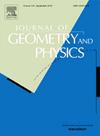Topological recursion and variations of spectral curves for twisted Higgs bundles
IF 1.6
3区 数学
Q1 MATHEMATICS
引用次数: 0
Abstract
Prior works relating meromorphic Higgs bundles to topological recursion, in particular those of Dumitrescu-Mulase, have considered non-singular models that allow the recursion to be carried out on a smooth Riemann surface. We start from an -twisted Higgs bundle for some fixed holomorphic line bundle on the surface. We decorate the Higgs bundle with the choice of a section s of , where K is the canonical line bundle, and then encode this data as a b-structure on the base Riemann surface which lifts to the associated Hitchin spectral curve. We then propose a so-called twisted topological recursion on the spectral curve, after which the corresponding Eynard-Orantin differentials live in a twisted cotangent bundle. This formulation retains, and interacts explicitly with, the singular structure of the original meromorphic setting — equivalently, the zero divisor of s — while performing the recursion. Finally, we show that the twisted Eynard-Orantin differentials compute the Taylor expansion of the period matrix of the spectral curve, mirroring a result of Baraglia-Huang for ordinary Higgs bundles and topological recursion. Starting from the spectral curve as a polynomial form in an affine coordinate rather than a Higgs bundle, our result implies that, under certain conditions on s, the expansion is independent of the ambient space in which the curve is interpreted to reside. While our focus is almost exclusively geometric, we include some preliminary thoughts on connections to questions in theoretical condensed matter physics.
求助全文
约1分钟内获得全文
求助全文
来源期刊

Journal of Geometry and Physics
物理-物理:数学物理
CiteScore
2.90
自引率
6.70%
发文量
205
审稿时长
64 days
期刊介绍:
The Journal of Geometry and Physics is an International Journal in Mathematical Physics. The Journal stimulates the interaction between geometry and physics by publishing primary research, feature and review articles which are of common interest to practitioners in both fields.
The Journal of Geometry and Physics now also accepts Letters, allowing for rapid dissemination of outstanding results in the field of geometry and physics. Letters should not exceed a maximum of five printed journal pages (or contain a maximum of 5000 words) and should contain novel, cutting edge results that are of broad interest to the mathematical physics community. Only Letters which are expected to make a significant addition to the literature in the field will be considered.
The Journal covers the following areas of research:
Methods of:
• Algebraic and Differential Topology
• Algebraic Geometry
• Real and Complex Differential Geometry
• Riemannian Manifolds
• Symplectic Geometry
• Global Analysis, Analysis on Manifolds
• Geometric Theory of Differential Equations
• Geometric Control Theory
• Lie Groups and Lie Algebras
• Supermanifolds and Supergroups
• Discrete Geometry
• Spinors and Twistors
Applications to:
• Strings and Superstrings
• Noncommutative Topology and Geometry
• Quantum Groups
• Geometric Methods in Statistics and Probability
• Geometry Approaches to Thermodynamics
• Classical and Quantum Dynamical Systems
• Classical and Quantum Integrable Systems
• Classical and Quantum Mechanics
• Classical and Quantum Field Theory
• General Relativity
• Quantum Information
• Quantum Gravity
 求助内容:
求助内容: 应助结果提醒方式:
应助结果提醒方式:


